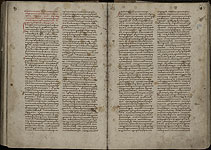Pachomius the Serb and his Autograph
«The Life of St. Sergius of Radonezh» has survived in many different versions. Among hundreds of the copies of «The Life», Pachomius Logothetes' autograph occupies a distinguished place. To prove this, we briefly describe the history of the work.
St. Sergius of Radonezh died on 25 September 1391/1392. 26 years later, i.e., around 1417-1418, his disciple Epiphanius the Wise, a monk and a future confessor of the Trinity Monastery of St. Sergius, finished his account of the life of the saint. The writings cover the author's own memories of the teacher, as well as the stories of other contemporaries.
Epiphanius the Wise is known as Old Russian writer, whose literary style was given the name pletenie sloves, or "the weaving of words". The author's own speech was cleverly interwoven with quotations from Scripture and the early Christian theologians, the author uses an abundance of specific, deliberate constructions of language. Despite the idealized character, Epiphanius' «Life» contained a number of factual information about the saint. The story ended with the death of St. Sergius of Radonezh and did not mention about finding his relics, which took place in 1422.
Epiphanius' original manuscript has not survived and came down to us in rewritings, "revisions" made by another famous writer - Pachomius the Serb.The 15th-century Serbian hagiographer Pachomius Logothetes, who, after taking monastic vows on Mount Athos, moved to Russia in the 1430s and resided at the Trinity Monastery of St. Sergius for a long time. There he copied books and compiled the lives of saints, mostly, from materials of predecessors. In the 1470s, he settle in Novgorod where he wrote a set of the lives of local saints . Pachomius composed also The Life of St. Cyril of Beloozero, after spending a few months in the Kirillo-Belozersky Monastery (St. Cyril of Beloozero's Monastery) and leaving another of his autographs in the famous miscellany of the scribe Euphrosynus.
Pachomius the Serb became famed as a skilled stylist - his writings were considered exemplary hagiographical works. Many lives of Russian saints in his version were included in the Great Monthly Readings (Velikiye Chet’yi-Minei), compiled in the 16th century under the supervision of Metropolitan Macarius of Moscow and then reproduced in numerous books of readings.As mentioned before, the discovery of the relics of St. Sergius of Radonezh in 1422 preceded the canonization of a saint. Probably, Pachomius Logothetes revised Epiphanius' «Life of St. Sergius» to adapt it to the church service. Pachomius shortened Epiphanius' work, omitted many biographical details and replaced them, according to the hagiographic canon, with generalities and biblical quotations to make the narration more solemn. In addition, Pachomius added the story about finding the relics of St. Sergius and subsequent miracles.
The early manuscript copies of «Life of St. Sergius of Radonezh» show that Pachomius the Serb created several versions of the work, while improving text. Studies of many researchers prove that there are at least three variants. All of them have been preserved in copies, but none of the surviving manuscripts were written by the author's hand. This explains the exceptional importance of Pachomius Logothetes' autograph, which is found in the collections of the National Library and presented on our site.
A study of Pachomius the Serb' autograph shows that it has distinguished features. The autograph can be attributed to the last stage of Pachomius' work on the «Life of St. Sergius», because the text ended with the story about finding the relics of the saint and wonders. The first two editions do not yet include these additions. Obviously, these versions which have been preserved in a small number of copies (the earliest of the copies can be dated back to the mid 15th century: RGB, the collection of the Trinity Monastery of St. Sergius, no. 746), were preparatory. The third version was the last. Compare the all three variants, you can see how the author improved his work: in the third edition, he made sentences from fragments of phrases of the first and the second versions to making text better and more logical. For this purpose, Pachomius ommited many biographical details, with which was full the biography composed by his predecessor - Epiphanius the Wise. Pachomius sometimes changed the position of episodes, ignoring the chronology of events. Everything was subordinated to the main idea to give irrefutable proofs of holiness of St. Sergius.


